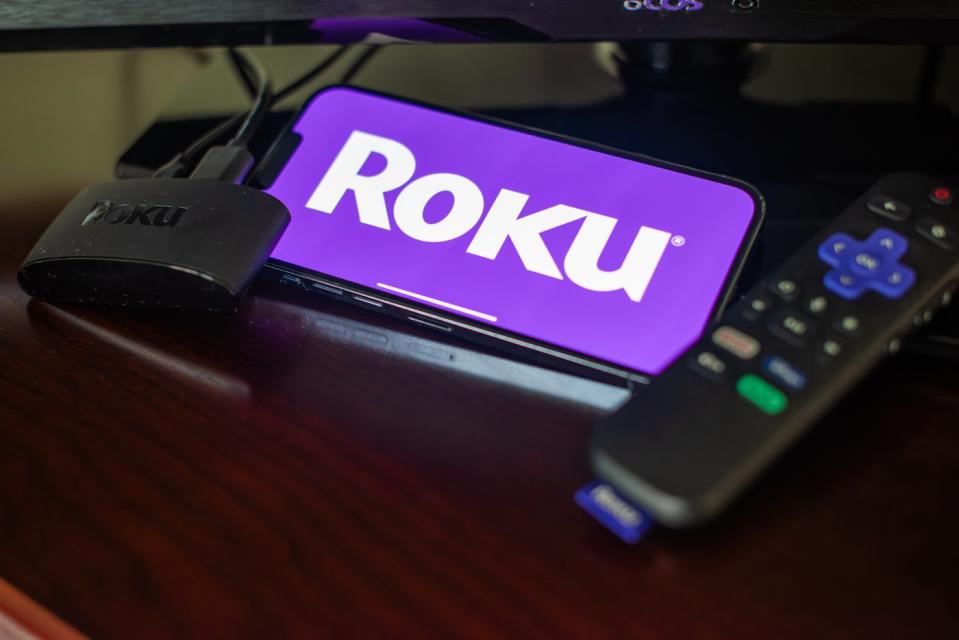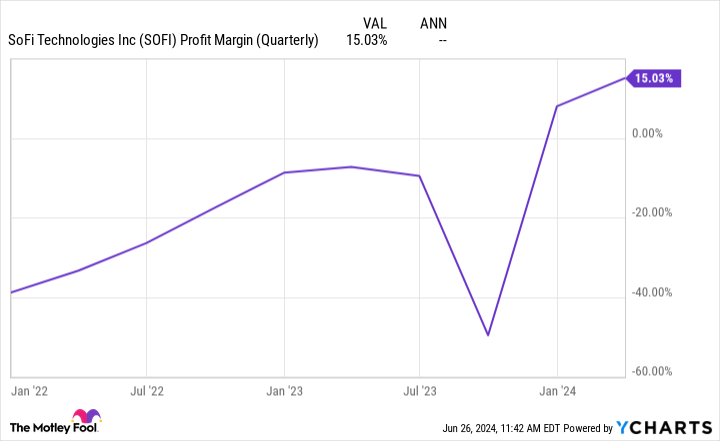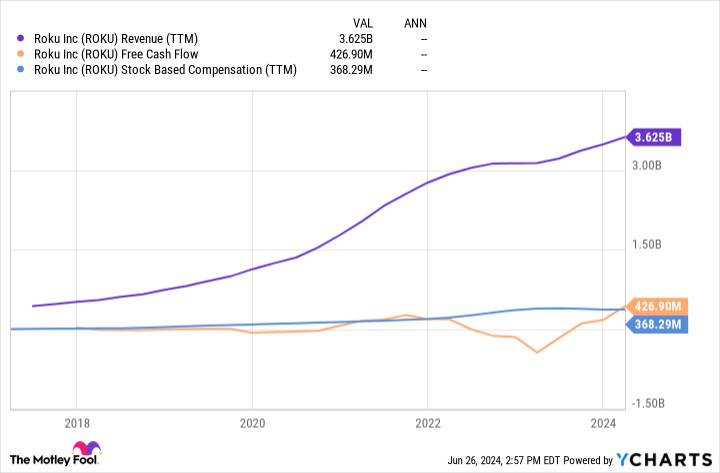

Adhering to the Gardner-Kretzmann Continuum that suggests individual investors hold at least as many stocks as they are years old, I currently have 36 core holdings in my retirement account. While I own many more starter-sized positions of other stocks as well, I focus the majority of my monthly dollar-cost averaging (DCA) buys on these 36 holdings.
So far in 2024, my worst-performing stocks among these 36 businesses have been fintech SoFi Technologies (NASDAQ: SOFI) and streaming platform Roku (NASDAQ: ROKU), which are down between 36% and 38%. As disheartening as these drops are, they are a standard part of being an individual investor — and I have absolutely no interest in selling right now.
Why?
I have a serious case of FOMO (fear of missing out) when it comes to selling a stock too early, only to watch it become a multibagger over the coming decades. Consider Nvidia when its share price went essentially nowhere for a decade in the early 2000s. Or how bad Amazon looked after the failed launch of its Fire phone. Or how disjointed Netflix looked amid its Qwikster debacle.
All of these stocks have since become multibaggers following what initially looked like reasonable times to sell. So, instead of selling, I’d much rather pause my DCA additions and leave a struggling stock alone — seeing what happens over a longer time frame.
With that said, here’s why I’m far from ready to panic over the sell-off so far in 2024 for SoFi and Roku — and why one of them looks downright interesting at today’s prices.
1. SoFi Technologies
Shares of diversified fintech SoFi have slid about 35% so far in 2024, despite the company beating estimates on both the top and bottom lines in its most recent quarter. After its revenue rose by 26% in the first quarter of 2024 — despite its largest unit, lending (personal, student, and home loans), delivering little growth — SoFi is becoming a well-rounded financial power.
The company’s young financial services segment produced 86% sales growth as people continued to flock to SoFi’s Money accounts, which currently offer 4.6% interest rates. These enticing rates brought in another $3 billion in deposits during the quarter, increasing the company’s total to more than $21 billion. These deposits are critical to the company’s success over the long term, as they provide a stable source (90% comes from recurring direct deposits) of lower-cost funding for its lending segment.
Meanwhile, the company’s technology platform segment — which management wants to build into the “AWS [Amazon Web Services] of fintech” — increased revenue by 21% as the company continued courting large banks in North and South America.
Best yet for investors? Despite the market’s adverse reaction toward management’s cautious outlook for the second quarter, SoFi’s net profit margin continues to trend higher (outside of a one-time event in 2023).
With its management forecasting earnings-per-share to grow to between $0.55 and $0.80 by 2026, SoFi’s current share price of around $6.50 could prove to be a deep discount. Furthermore, Chief Executive Officer Anthony Noto continues to buy shares of the company’s stock. Considering SoFi’s growth potential, early profitability, and robust liquidity from its growing deposit base, I’ll happily keep buying shares alongside Noto.

2. Roku
Streaming platform leader Roku’s share price has continued its sharp decline ever since being deemed one of the “pandemic darlings” in 2020 and 2021. It’s down 38% so far in 2024. Now 88% below its all-time highs, Roku trades with a price-to-sales (P/S) ratio of only 2.2, which is near its lowest-ever mark at 1.7.
Naturally, this steep drop in price and valuation makes the company a rather interesting turnaround story. After its streaming households count rose by 14% to 84 million and its streaming hours by 23% to 31 billion in the first quarter of 2024, there is a strong argument that Roku is worth buying today.
Furthermore, the company’s Roku Channel has now grown to become the third-largest streaming app on its platform, helping to draw roughly 120 million viewers to the Roku home screen every day.
After partnering with The Trade Desk and its industry-leading connected TV (CTV) advertising prowess, Roku is poised to improve its monetization from the 84 million households it reaches. By pairing The Trade Desk’s advertising solutions and deep client roster with Roku’s treasure trove of customer data, the partnership should allow advertisers to deliver more targeted marketing campaigns, maximizing their ad spend.
With streaming services now capturing 60% of total hours viewed versus linear TV but only receiving 30% of total ad spending, there is a long growth runway remaining for this partnership to continue paying dividends.
As great as all of these factors are, however, I am not ready to go all-in on Roku at today’s potentially discounted price. While free cash flow (FCF) has improved dramatically over the last year following Chief Financial Officer Dan Jedda’s arrival from Amazon and later Stitch Fix, the company’s stock-based compensation (SBC) remains a concern for me.
Consider the following chart.
Once we subtract Roku’s SBC from its FCF, we see that it only has an adjusted 1.6% FCF margin over the last year. While this is an improvement from 2022’s negative FCF, I would rather be patient with Roku and see if its cash generation and profitability can continue to improve.
However, thanks to the ongoing shift in ad spend toward CTV working in Roku’s favor, the company’s deal with The Trade Desk, and its industry-leading reach, I wouldn’t dream of selling my position yet, either. With Roku already a healthy 2% position in my retirement account, I’m perfectly happy to be patient — and give the long-term megatrends working in the company’s favor time to play out.
Should you invest $1,000 in SoFi Technologies right now?
Before you buy stock in SoFi Technologies, consider this:
The Motley Fool Stock Advisor analyst team just identified what they believe are the 10 best stocks for investors to buy now… and SoFi Technologies wasn’t one of them. The 10 stocks that made the cut could produce monster returns in the coming years.
Consider when Nvidia made this list on April 15, 2005… if you invested $1,000 at the time of our recommendation, you’d have $774,526!*
Stock Advisor provides investors with an easy-to-follow blueprint for success, including guidance on building a portfolio, regular updates from analysts, and two new stock picks each month. The Stock Advisor service has more than quadrupled the return of S&P 500 since 2002*.
*Stock Advisor returns as of June 24, 2024
John Mackey, former CEO of Whole Foods Market, an Amazon subsidiary, is a member of The Motley Fool’s board of directors. Josh Kohn-Lindquist has positions in Netflix, Nvidia, Roku, SoFi Technologies, and The Trade Desk. The Motley Fool has positions in and recommends Amazon, Netflix, Nvidia, Roku, Stitch Fix, and The Trade Desk. The Motley Fool has a disclosure policy.
Halfway Through 2024: Why I’m Not Panicking About the 2 Worst-Performing Growth Stocks in My Retirement Account was originally published by The Motley Fool
EMEA Tribune is not involved in this news article, it is taken from our partners and or from the News Agencies. Copyright and Credit go to the News Agencies, email news@emeatribune.com Follow our WhatsApp verified Channel











